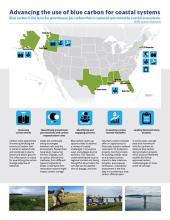
Blue carbon is the term for greenhouse gas carbon that is captured and stored by coastal ecosystems.
Coastal wetlands capture carbon dioxide from the atmosphere and permanently store carbon in wetland soils. This “blue carbon ” service can be used to inform and incentivize wetland restoration; however, the science behind blue carbon and the role of carbon finance in support of coastal restoration and conservation are still emerging.
Since 2010, the National Estuarine Research Reserve System (NERRS) and its partners have been filling key information gaps and fostering collaborations to advance understanding and application of blue carbon for the management of coastal wetlands. Projects have helped to quantify the carbon storage potential of coastal wetlands, predict greenhouse gas fluxes, and assess the market feasibility of using carbon offsets to support wetland restoration.
About this collection
Representatives from the projects featured in this collection participated in a panel webinar on March 17, 2020 to discuss lessons learned and next steps, opportunities, and needs for blue carbon and wetland management. The management brief below also contains summary elements highlighting key takeaways from the panel discussion.
Collection resources
Panel Webinar: Session Recording (YouTube)
In this webinar, panelists representing four regions across the United States shared lessons learned from their work leading blue carbon projects, and offered ideas for advancing the use of blue carbon for coastal wetland management.
Management Brief and Infographic: Advancing the Use of Blue Carbon for Coastal Systems (PDF)
This management brief features the work of teams in four regions across the United States that have received support through the NERRS Science Collaborative. We emphasize key aspects of their work: developing models that predict carbon fluxes locally and evolving them to increase regional relevance; assessing and cataloging carbon stocks for regional and national use; performing assessments and feasibility studies to explore restoration financing through carbon markets; and developing resources and strategies for communicating with communities and decision makers about advancing the use of blue carbon for coastal systems.
This document was prepared by NERRS Science Collaborative staff, with input from Craig Cornu, Tonna-Marie Surgeon Rogers, Stefanie Simpson, Coowe Walker, and their project partners.